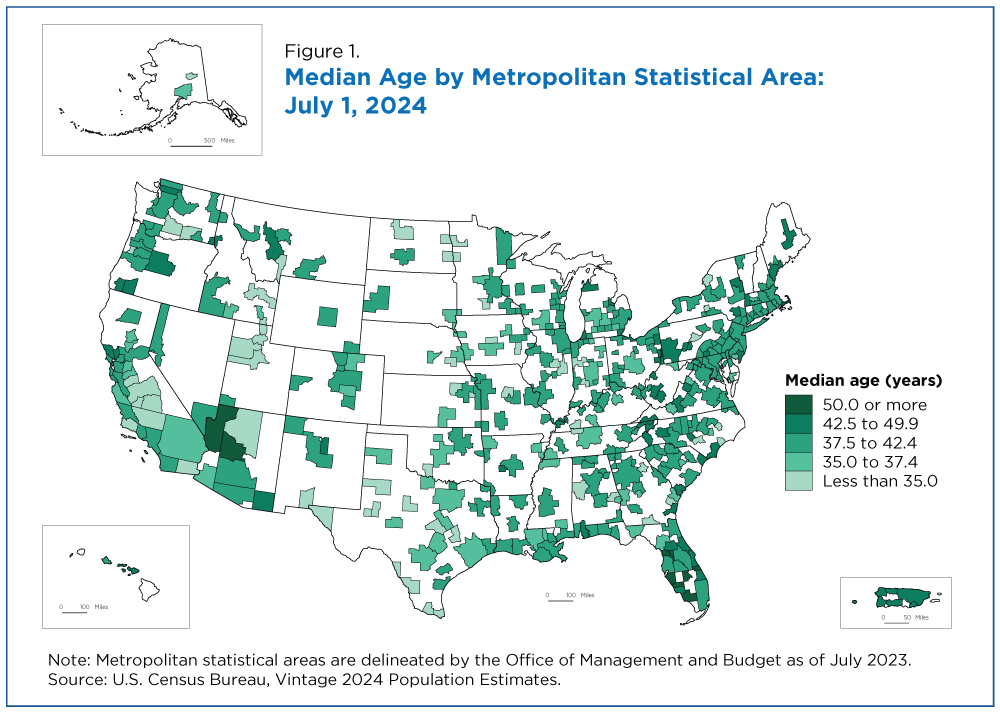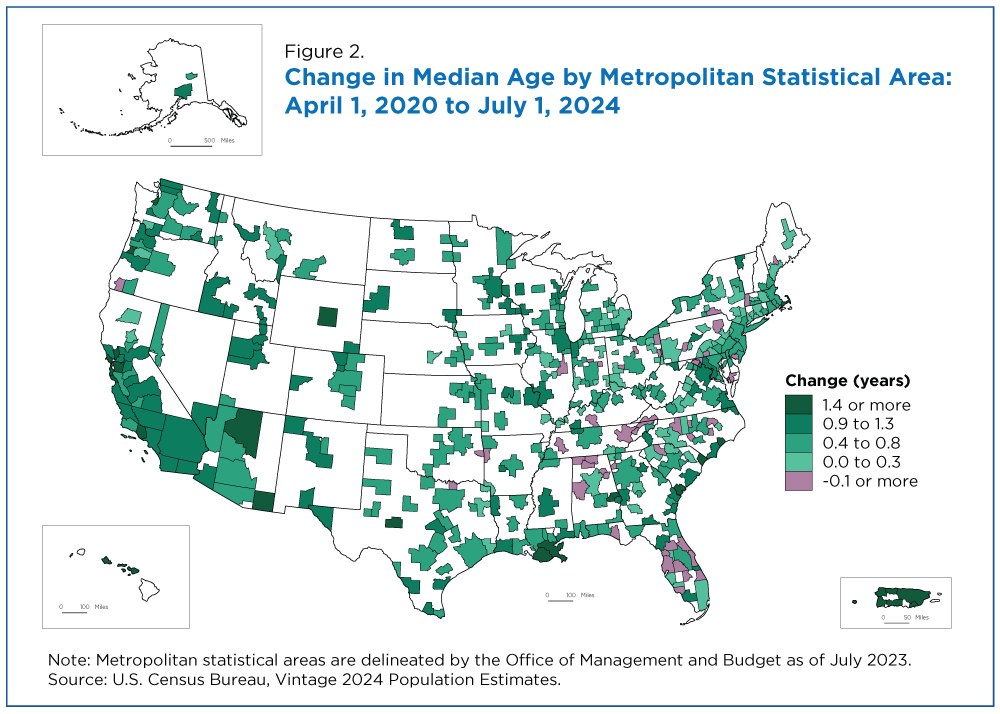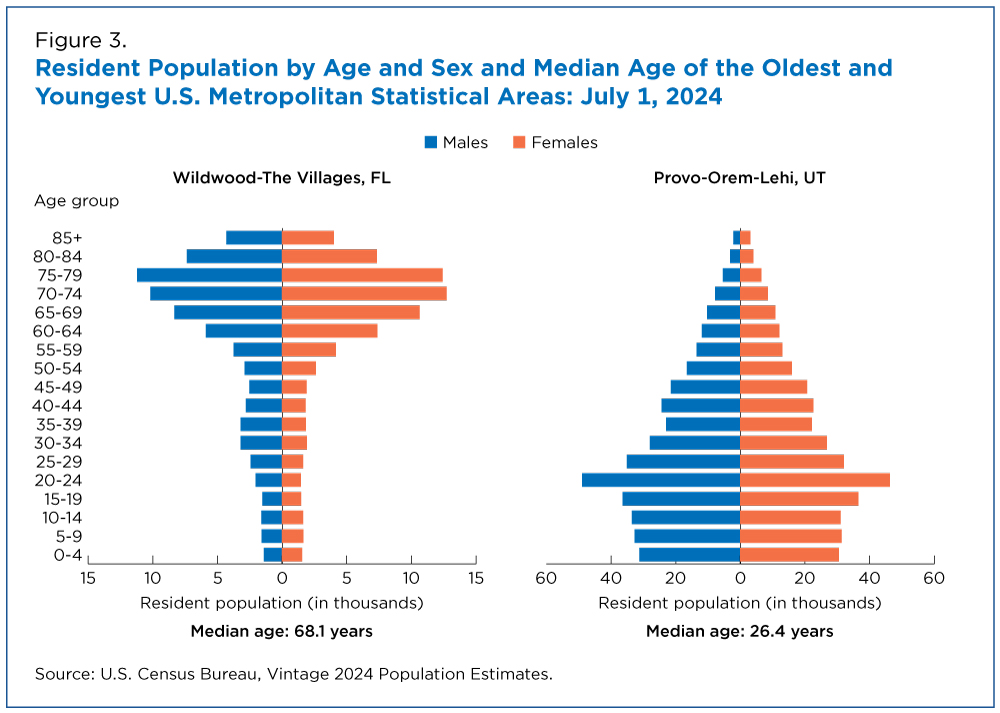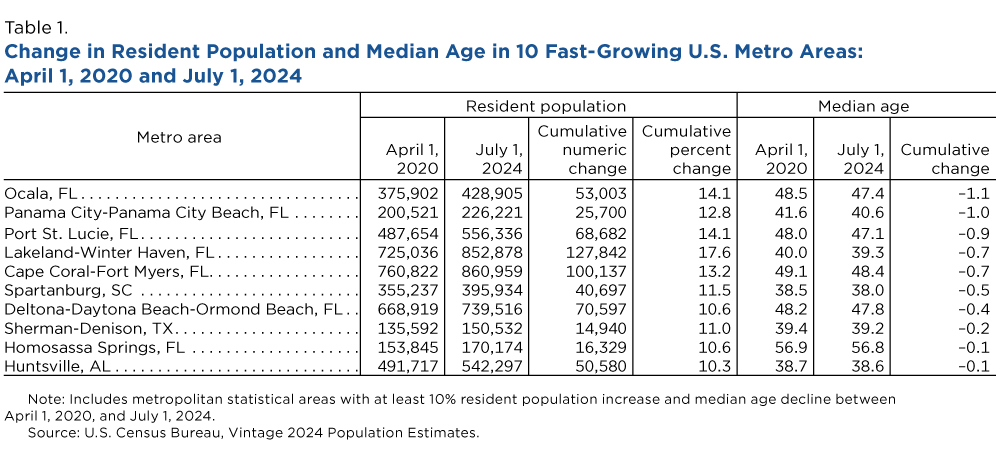Median Age in 192 Metro Areas Higher Than National Median of 39.1
July 1, 2025

The U.S. median age — the age at which half the population is aged above and the other half below — has increased by 0.6 years from April 2020 to July 2024 when it reached 39.1, according to U.S. Census Bureau population estimates released today.
Between April 2020 and July 2024, the median age rose in 329 of the nation’s 387 metro areas. At the same time, 47 metro areas experienced a decline in median age — many of which were in the South, including some in Florida.
Given that nearly 294 million people (86% of the U.S. population) lived in one of the nation’s 387 metro areas in 2024, many metro areas saw an increase in their median ages, too.
Median ages in metro areas in 2024 ranged between 26.4 and 68.1, with 192 metro areas having a median age higher than the nation’s.
Many of the metro areas with the highest median ages were in Florida and Arizona, both popular retirement destinations (Figure 1).
Metro areas with the lowest median ages tended to have one of two things: a relatively high proportion of young adults, often due to the presence of a college/university or large military installation; or a relatively high proportion of children. Some had both.
Metro Area Aging Trends
Between April 2020 and July 2024, the median age rose in 329 of the nation’s 387 metro areas (Figure 2). At the same time, 47 metro areas experienced a decline in median age — many of which were in the South, including some in Florida. The median ages of 11 metro areas did not change during the period.
Metro Areas With Oldest and Youngest Median Ages
The median age increase in many metro areas aligned with the national aging trend: 61.2 million people aged 65 and over lived in the United States in 2024, up 13% from 54.2 million in 2020, in contrast to a decline in the number of children (ages 0 to 17).
The metro area with the highest median age in 2024 (68.1) was Wildwood-The Villages, FL, where 57% of the population was 65 and older reflecting the presence of a large retirement community. Two other Florida metro areas — Punta Gorda and Homosassa Springs — followed closely with the second- (60.1) and third-highest (56.8) median ages, respectively. More than 35% of both populations were 65 and older.
Metro areas with the youngest median age were in Provo-Orem-Lehi, UT (26.4 years) and Logan, UT-ID (27). Both metro areas have a large university.
The result was two vastly different age structures in the nation’s oldest and youngest metro areas in 2024: Older adults dominated the population in Wildwood-The Villages, while there was a higher share of children and young adults in Provo-Orem-Lehi (Figure 3).
Rising and Falling Median Ages
Some metro areas with relatively large shares of the aging population experienced sharper increases in median age than others. For instance, South Carolina’s Hilton Head Island-Bluffton-Port Royal and Myrtle Beach-Conway-North Myrtle Beach metro areas had the largest median age hikes from 2020 to 2024: 3.1 and 2.1 years, respectively.
Despite growth in the 65-and-older demographic, the median age in 47 metro areas decreased between 2020 and 2024. While the United States is characterized by its increasingly large older adult population — a byproduct of factors such as a sizeable baby boomer population and declining 0-17 demographic — these exceptions underscore that age patterns can differ, especially in some fast-growing metro areas.
Between 2020 and 2024, 10 metro areas – all of them in the South and seven in Florida – had their total populations rise by at least 10% and their median ages drop (Table 1).
For instance:
- Ocala, FL, saw a 14.1% increase in population while its median age dropped by 1.1 years to 47.4.
- Lakeland-Winter Haven, FL, and Cape Coral-Fort Myers, FL, had respective population gains of 17.6% and 13.2% and median age dips of 0.7 years to 39.3 and 48.4, respectively.
- The population of Sherman-Denison, TX, increased by 11.0%, while its median age went down 0.2 years to 39.2.
In those 10 metro areas, where positive net domestic migration tended to play an important role in their population growth, increases in the number of children and the younger adult population at least partially helped offset aging patterns. That resulted in a decline in median age even amid growth in the number of older adults. This contrast underscores a more nuanced picture of the intersection of population growth and aging in U.S. metro areas.
































